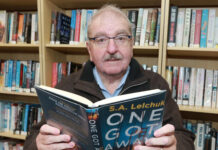
There’s an old joke that tells of a man who visits New York to attend a concert, but gets lost. He spots a musician carrying a violin case and asks “Sir, can you tell me how to get to Carnegie Hall?” The violinist smiles and says, “Practice”.
Carnegie Hall was one of the many philanthropic enterprises of millionaire Andrew Carnegie, who, despite his generosity, tended to name his gifted buildings after himself.
In 1901, Mayor John Daly wrote to Andrew Carnegie looking for a grant as the Corporation was in the process of locating a suitable venue for a library in Limerick city. The following year, the fourth Earl of Limerick, William Pery offered a free site, a portion of the People’s Park on Pery Square.
On the invitation of the Limerick Corporation, Andrew Carnegie arrived on a flying visit on October 20, 1903, to lay the foundation stone of the new library.
That day the streets Carnegie was due to travel on – including Patrick Street, Glentworth Street, and the People’s Park – were decorated in lines with flags. Many of the businesses of the city also draped flags from their windows. Just before noon, a crowd began to gather as the citizens of the city wanted to catch a glimpse of one of the richest people in the world.
The train carrying the philanthropist arrived in to Limerick at half past one. He was immediately greeted by the Mayor and the High Sheriff, both donned in their official regalia, a Rev T Lee, and the Town Clark, W M Nolan.
Nolan had carried out all the correspondence on behalf of the city to Carnegie. The men, with the exception of the High Sheriff, boarded an open top carriage and made their way to the home of the Protestant Bishop of Limerick on Henry Street, where a fine lunch was laid out.
Following the lavish feast, the now large group moved on to the Council Chamber in Town Hall, which was then situated on Rutland Street.
When the train of carriages arrived, they were met by the fire brigade, who had formed a guard of honour in the hall. Here, Andrew Carnegie received the highest honour of the city, the Freedom of Limerick, from Mayor Michael Donnelly. The casket that held his freedom scroll was made from oak removed from St Mary’s Cathedral.
The next stop on his journey that day was to the then vacant lot on the edge of the People’s Park. Here, beneath a canopy, Carnegie was led to a stone with a carved recess.
Four sealed bottles were placed in the recess. These contained copies of the four Limerick newspapers of the day, a selection of coins, and a parchment detailing those responsible for the erection of the library.
After a series of speeches, stomachs began to rumble. The last meal of the day was a banquet held in Cruise’s Hotel. This was a large affair where a majority of the guests were members of the local and national press. Although, the local notables were the life of the party as some, including Sir Charles Barrington, regaled the crowd with song.
Andrew Carnegie spent the night in the hotel before catching a train to Cork just after eight o’clock the following morning. He also received the freedom of Cork and Waterford during this visit to Ireland. It would take another three years for the Carnegie Free Library and Museum at Pery Square to open its doors to the public.
The building is now used as the Limerick City Gallery of Art. The library and museum moved several times through the years. The Limerick Museum is today on Henry Street, while the library is in a temporary location on Michael Street until its permanent home in the Opera Centre is completed.
This was not the only library in County Limerick to take advantage of the Carnegie scheme. As Carnegie’s library funding progressed, very few of the towns that requested a grant, committing to his terms for operation and maintenance, were refused.
The Carnegie library grant system ended with the death of the philanthropist in 1919. This allowed at least fifteen libraries created in the county between 1903 and 1917.
The majority of these were in the west of the county, with the first being in Rathkeale in 1903. It was followed by others in the Rathkeale district, Croagh, Ballyhahill, Kildimo, Pallaskenry, Ballysteen, Askeaton, Shanagolden, and Kilcolman.
By 1929, the majority of these smaller libraries were no longer used as libraries but as social halls. Kilcolman never seemed to get off the ground as in 1919 it had no books in stock. Shanagolden had no books from 1920 as they were burned by the Black and Tans. Pallaskenry had no books from 1924, but used the space for cookery classes and dances.
All the while the number of books on offer in the other libraries in 1929 were extremely low. Kildimo had a total of 25 books on its shelves, Askeaton had 50, but the most popular library was Ballysteen with 40 books on a three month rotation with the main library.
The rural district of Newcastle West also availed of the scheme. The main library in Newcastle West was opened in 1916. Smaller libraries were opening in the district in the following year but some had very little success.
The Knockaderry library never contained any books and instead in its first decade it was used mostly for Irish classes. The library in Broadford was quickly abandoned and in 1929 looked almost derelict, it picked up after this and was officially closed in 2011.
The Clouncagh library, like that in Shanagolden, was also attacked by the Black and Tans in 1920, but they destroyed the furniture in the building and not the books, which were on loan from the central library in Newcastle West.
In 2013, the branch at Shanagolden was officially decommissioned as a library and officially handed over to Shanagolden Community Council. The library in Athea was in good working order ten years after it opened and remained open until 2010. The most successful small library in the district was Feenagh, which, in 1929, had all its books out with readers but in 2011, like so many of the other small libraries before, it too closed.
By the time the Carnegie library scheme had ended, over 2,500 libraries were built throughout the world. Some of these are still extant and serving their communities over one hundred years later, albeit not always as a library.
For further reading on Carnegie libraries in Ireland, check out:
Brendan Grimes, “Carnegie Libraries in Ireland”, History Ireland, Issue 4 (winter 1998), Volume 6.








